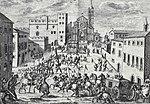Pellegrini Chapel (San Bernardino)
Chapels in ItalyRenaissance architectureRenaissance architecture in ItalyRenaissance architecture in Verona

The Pellegrini Chapel (Italian: Cappella Pellegrini), initially named "Guaresco," is a religious building commissioned by Countess Margherita Pellegrini to the famous architect Michele Sanmicheli and built between 1528 and 1559. It occupies a prominent place in Renaissance architecture.It is located within the Franciscan complex of San Bernardino in Verona, which consists of a Gothic-style church and a series of valuable cloisters and became a coveted place for Verona's noble families to build their aristocratic chapels between the 15th and 16th centuries.
Excerpt from the Wikipedia article Pellegrini Chapel (San Bernardino) (License: CC BY-SA 3.0, Authors, Images).Pellegrini Chapel (San Bernardino)
Via Antonio Rosmini, Verona San Zeno
Geographical coordinates (GPS) Address Nearby Places Show on map
Geographical coordinates (GPS)
| Latitude | Longitude |
|---|---|
| N 45.43894 ° | E 10.98139 ° |
Address
San Bernardino
Via Antonio Rosmini
37123 Verona, San Zeno
Veneto, Italy
Open on Google Maps









